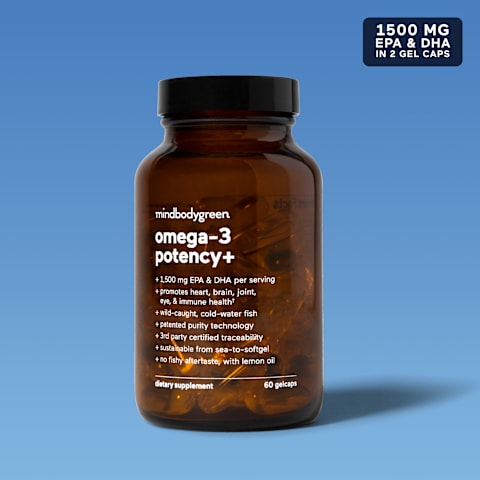Why Omega-3s Are A Non-Negotiable For Women 40+


Omega-3s are well known by now as a healthy fat that most of us could use more of in our diet. In fact, nearly 95% of Americans aren't getting the omega-3s they need. While increasing your intake is always a smart choice, women 40+ should be especially mindful about getting enough EPA and DHA, the two essential omega-3 fatty acids.
Here’s why, and what you can do to increase your intake.
They help protect your heart
In your 40s, cholesterol, triglycerides, and blood pressure can start to creep up—even with healthy habits. That’s because estrogen fluctuations during perimenopause start to gradually weaken the cardiovascular system.
Estrogen helps keep blood vessels flexible and supports healthy cholesterol. When levels drop, heart disease risk rises.
Omega-3s’ anti-inflammatory effects help counteract these negative changes thanks to their anti-inflammatory and blood vessel-supporting benefits.
Studies show that women who consume more omega-3s (whether from fatty fish like salmon and sardines or from high-quality supplements) tend to have healthier cholesterol levels and blood flow, both critical for reducing heart attack and stroke risk.
They support memory & reduce dementia risk
Omega-3s (particularly DHA) also play a pivotal role in supporting brain function and memory, while protecting against cognitive decline (like dementia and Alzheimer’s disease).
In one long-term study, older adults who regularly took omega-3 supplements had a remarkable 64% lower risk of developing Alzheimer’s1 over six years. And a meta-analysis of more than 100,000 people found that higher omega-3 intake was linked to about a 20% lower risk of dementia or cognitive decline.
Brain changes linked to decline can start in your 40s, long before symptoms appear2, making midlife a critical window for prevention.
They may reduce hot flashes
Over 80% of women will experience hot flashes in their lives, often starting in their mid-to-late 40s.
In one clinical trial, women (ages 40 to 55) who took an omega-3 supplement for 8 weeks had a significant drop in hot flash frequency3. This was equal to about 1.6 fewer hot flashes a day.
Increasing your omega-3 intake
There are two key ways to increase your intake of omega-3 fats: food and supplements.
Fatty fish is by far the best dietary source of EPA and DHA omega-3 fats. Just three ounces of salmon provides almost 2,000 milligrams of EPA and DHA, and three ounces of anchovies gets you around 1,500 milligrams. If you like fish, try to get at least two servings of salmon, anchovies, mackerel, and herring a week.
However, supplements are the most efficient way to get a therapeutic dose of omega-3 fats. To reap the benefits mentioned above, it’s vital to get at least 1,000 milligrams up to 2,200 milligrams of combined EPA and DHA a day.
There are a lot of iffy fish oil supplements out there, so we did the research for you and narrowed down our top, expert-vetted omega-3 supplement picks here.
The takeaway
Navigating new health concerns and preventing future ones in your 40s can feel overwhelming. Starting with foundational habits, like increasing omega-3 intake through food and a high-quality supplement, is a simple yet effective place to start.
